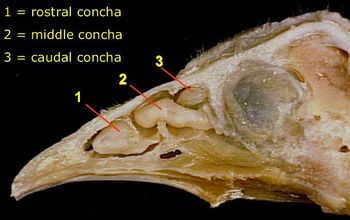Avian Respiration - Anatomy & Physiology
Jump to navigation
Jump to search
BACK TO ANATOMY & PHYSIOLOGY
|
|
Introduction
The avian respiratory system contains some fundamental changes to the mammalian system.
Avian Nasopharynx and Oropharynx
- The nostrils of the bird, which lead into the nasal cavity, may have a flap of horn to protect them, known as the Operculum.
- The Oral Cavity and the Nasal Cavity of the bird are interconnecting via a slit in the hard palate called the Choana.
- There are Rostral, Middle and Caudal Conchae arising from the lateral wall, filling part of the nasal cavity.
- Rostral Conchae - lined with Stratified Squamous Epithelium
- Middle Conchae - lined with Respiratory Epithelium.
- Birds lack a soft palate.
Birds vocalise using a syrinx.
Air Sacs
Links
References
- Dyce, K.M., Sack, W.O. and Wensing, C.J.G. (2002) Textbook of Veterinary Anatomy. 3rd ed. Philadelphia: Saunders.
